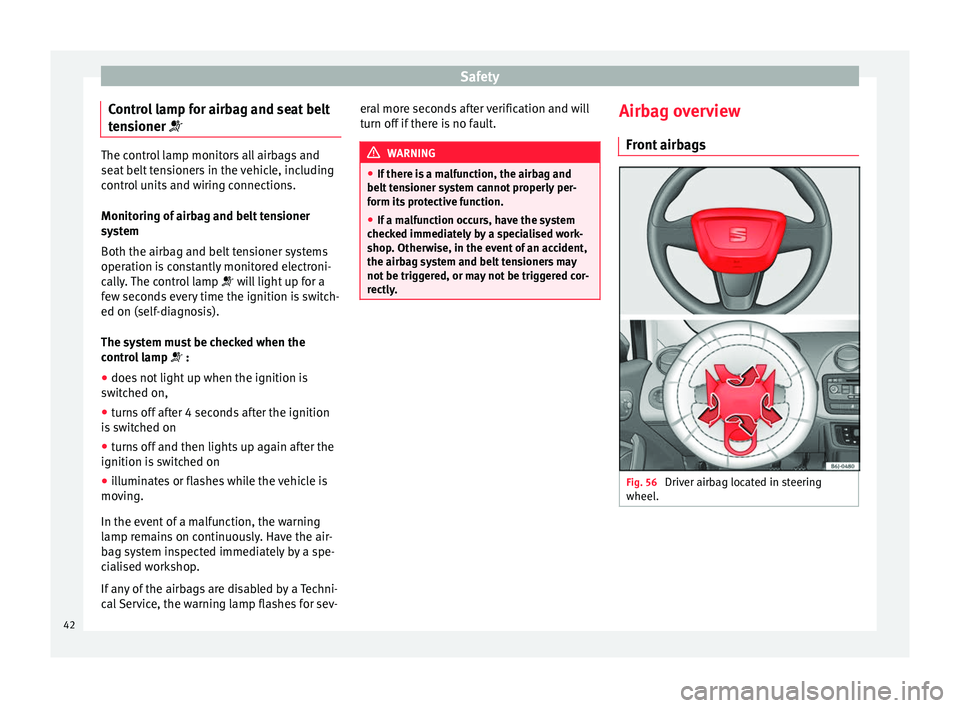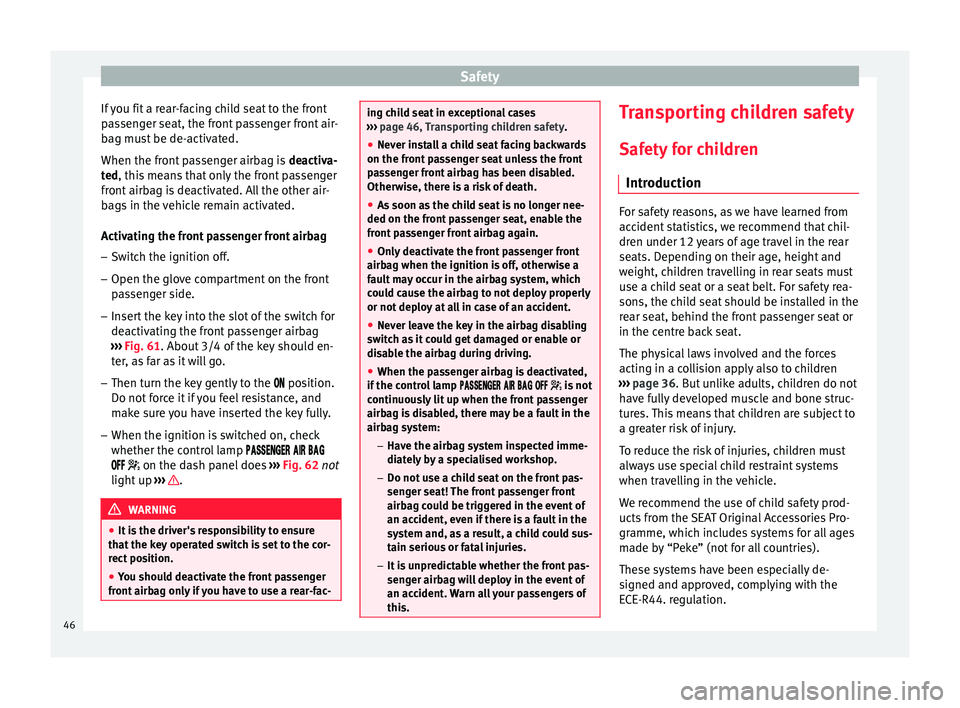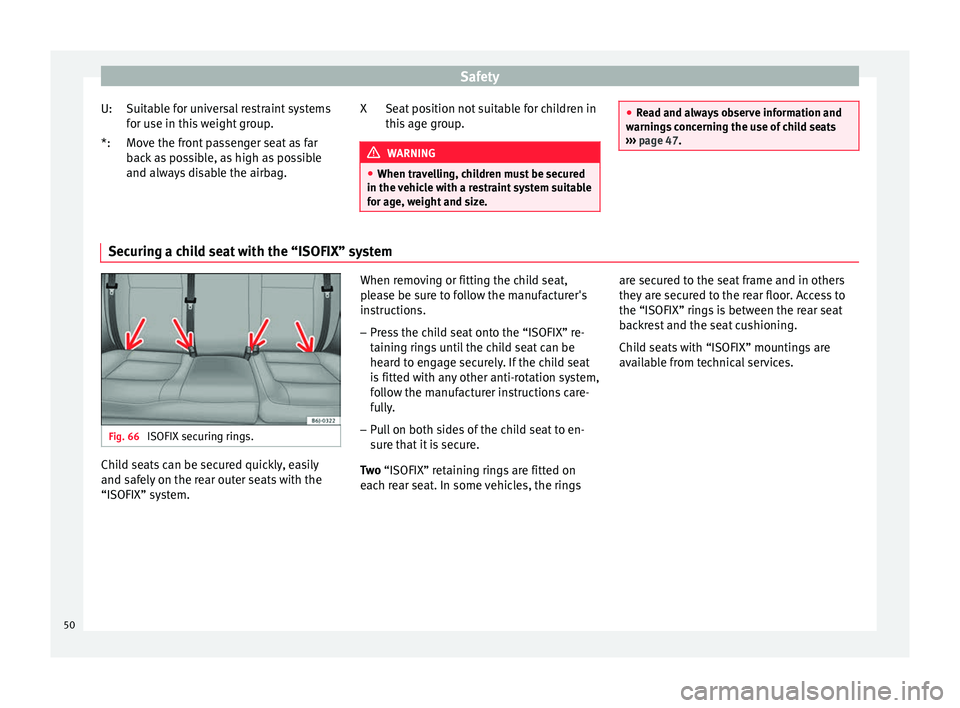2014 Seat Ibiza 5D airbag disable
[x] Cancel search: airbag disablePage 21 of 240

The essentialsSym-
bolMeaning of control and warning lampsFurther in-formation
If flashing:
the Electronic Sta-
bility Control (ESC) is working
or the ASR is working
If it remains lit: ESC or ASR
faulty››› page
60
››› page
60
Brake fluid required or
serious fault in brake system›››
page
61
Handbrake on›››
page
126
Cruise speed activated
(Cruise control)›››
page
61
Tyre pressure›››
page
61
Selector lever lock (automatic
gearbox)›››
page
62
Fuel level / reserve›››
page
62
Doors open›››
page
62
Rear lid open›››
page
62
Airbag or belt tensioner sys-
tem fault or airbag disabled›››
page
42
Main beam switched on›››
page
62
Start-Stop system switched
off›››
page
142
Sym-
bolMeaning of control and warning lampsFurther in-formation
Electro-hydraulic steering›››
page
62
Fault in the emission control
system›››
page
63
Coolant level / coolant tem-
perature›››
page
63
Alternator fault›››
page
63
If it stays lit:
ASR switched off
››› page
60
››› page
60
Turn signals in operation›››
page
63
SAFEElectronic immobiliser
››› page
64
››› page
79
››› in Overview of the warning lamps
on page 57
››› page 57 Gear lever
Manual gearbox Fig. 28
The position of the gears is indicated on the
gearbox lever
››› Fig. 28 .
● Pr e
ss the clutch pedal and keep your foot
right down.
● Move the gearbox lever to the required po-
sition.
● Release the clutch.
Selecting reverse gear
● Press the clutch pedal and keep your foot
right down.
● With the gearbox lever in neutral, push it
upwards, move it to the left as far as it will go
and then forwards to select reverse ››› Fig. 28
R .
» 19
Technical specifications
Advice
Operation
Safety
The essentials
Page 44 of 240

Safety
Control lamp for airbag and seat belt
tensioner The control lamp monitors all airbags and
seat belt tensioners in the vehicle, including
control units and wiring connections.
Monitoring of airbag and belt tensioner
system
Both the airbag and belt tensioner systems
operation is constantly monitored electroni-
cally. The control lamp
will light up for a
few seconds every time the ignition is switch-
ed on (self-diagnosis).
The system must be checked when the
control lamp :
● does not light up when the ignition is
switched on,
● turns off after 4 seconds after the ignition
is switched on
● turns off and then lights up again after the
ignition is switched on
● illuminates or flashes while the vehicle is
moving.
In the event of a malfunction, the warning
lamp remains on continuously. Have the air-
bag system inspected immediately by a spe-
cialised workshop.
If any of the airbags are disabled by a Techni-
cal Service, the warning lamp flashes for sev- eral more seconds after verification and will
turn off if there is no fault. WARNING
● If there is a malfunction, the airbag and
belt tensioner system cannot properly per-
form its protective function.
● If a malfunction occurs, have the system
checked immediately by a specialised work-
shop. Otherwise, in the event of an accident,
the airbag system and belt tensioners may
not be triggered, or may not be triggered cor-
rectly. Airbag overview
Front airbags Fig. 56
Driver airbag located in steering
wheel. 42
Page 48 of 240

Safety
If you fit a rear-facing child seat to the front
passenger seat, the front passenger front air-
bag must be de-activated.
When the front passenger airbag is deactiva-
ted , this means that only the front passenger
fr ont
airbag is deactivated. All the other air-
bags in the vehicle remain activated.
Activating the front passenger front airbag
– Switch the ignition off.
– Open the glove compartment on the front
passenger side.
– Insert the key into the slot of the switch for
deactivating the front passenger airbag
››› Fig. 61. About 3/4 of the key should en-
ter
, as far as it will go.
– Then turn the key gently to the position.
Do not force it if you feel resistance, and
make sure you have inserted the key fully.
– When the ignition is switched on, check
whether the control lamp
on the dash panel does ››› Fig. 62 not
light
up ››› .
WARNING
● It is the driver's responsibility to ensure
that the key operated switch is set to the cor-
rect position.
● You should deactivate the front passenger
front airbag only if you have to use a rear-fac- ing child seat in exceptional cases
››› page 46, Transporting children safety.
● Never install a child seat facing backwards
on the front passenger seat unless the front
passenger front airbag has been disabled.
Otherwise, there is a risk of death.
● As soon as the child seat is no longer nee-
ded on the front passenger seat, enable the
front passenger front airbag again.
● Only deactivate the front passenger front
airbag when the ignition is off, otherwise a
fault may occur in the airbag system, which
could cause the airbag to not deploy properly
or not deploy at all in case of an accident.
● Never leave the key in the airbag disabling
switch as it could get damaged or enable or
disable the airbag during driving.
● When the passenger airbag is deactivated,
if the control lamp is not
continuously lit up when the front passenger
airbag is disabled, there may be a fault in the
airbag system:
–Have the airbag system inspected imme-
diately by a specialised workshop.
– Do not use a child seat on the front pas-
senger seat! The front passenger front
airbag could be triggered in the event of
an accident, even if there is a fault in the
system and, as a result, a child could sus-
tain serious or fatal injuries.
– It is unpredictable whether the front pas-
senger airbag will deploy in the event of
an accident. Warn all your passengers of
this. Transporting children safety
Safety for children Introduction For safety reasons, as we have learned from
accident statistics, we recommend that chil-
dren under 12 years of age travel in the rear
seats. Depending on their age, height and
weight, children travelling in rear seats must
use a child seat or a seat belt. For safety rea-
sons, the child seat should be installed in the
rear seat, behind the front passenger seat or
in the centre back seat.
The physical laws involved and the forces
acting in a collision apply also to children
››› page 36 . But unlike adults, children do not
h av
e fully developed muscle and bone struc-
tures. This means that children are subject to
a greater risk of injury.
To reduce the risk of injuries, children must
always use special child restraint systems
when travelling in the vehicle.
We recommend the use of child safety prod-
ucts from the SEAT Original Accessories Pro-
gramme, which includes systems for all ages
made by “Peke” (not for all countries).
These systems have been especially de-
signed and approved, complying with the
ECE-R44. regulation.
46
Page 49 of 240

Transporting children safety
Follow the manufacturer's instructions and
observe any statutory requirements when in-
stalling and using child seats. Always read
and note ››› page 47 .
W e r
ecommend you always carry the manu-
facturer's Child Seat Instruction Manual to-
gether with the on-board documentation.
Important information on the front
passenger airbag Fig. 63
Passenger's side sun visor: airbag
sticker. Fig. 64
On the rear frame of the passenger
side door: airbag sticker. A sticker with important information about
the passenger airbag is located on the pas-
senger's sun visor and/or on the passenger
side door frame. Read and always observe
the safety information included in the follow-
ing chapters:
● Safety distance with respect to the passen-
ger airbag ››› page 40 .
● Ob
jects between the passenger and the
passenger side airbag ››› in Front airbags
on page 43 .
The p a
ssenger side front airbag, when ena-
bled, is a serious risk for a child that is facing
backward since the airbag can strike the seat
with such force that it can cause serious or
fatal injuries. Children up to 12 years old
should always travel on the rear seat.
Therefore we strongly recommend you to
transport children on the rear seats. This is the safest location in the vehicle. Alternative-
ly, the front passenger airbag can be disa-
bled with a key-operated switch
››› page 45.
When transporting children, use a child seat
appropriate to the age and size of each child. WARNING
● If a child seat is secured to the front pas-
senger seat, the risk to the child of sustain-
ing critical or fatal injuries in the event of an
accident increases.
● An inflating front passenger airbag can
strike the rear-facing child seat and project it
with great force against the door, the roof or
the backrest.
● Never install a child seat facing backwards
on the front passenger seat unless the front
passenger front airbag has been disabled.
Risk of potentially fatal injuries to the child!
However, if it is necessary, in exceptional ca-
ses, to transport a child in the front passen-
ger seat, the front passenger front airbag
must always be disabled ››› page 45, Front
passenger airbag deactivation*. If the front
passenger seat has a height adjustment op-
tion, move it to the highest position.
● For those vehicles that do not include a key
lock switch to deactivate the airbag, the vehi-
cle must be taken to a technical service.
● All vehicle occupants, especially children,
must assume the proper sitting position and
be properly belted in while travelling. » 47
Technical specifications
Advice
Operation
Safety
The essentials
Page 52 of 240

Safety
Suitable for universal restraint systems
for use in this weight group.
Move the front passenger seat as far
back as possible, as high as possible
and always disable the airbag.
U:
*:
Seat position not suitable for children in
this age group. WARNING
● When travelling, children must be secured
in the vehicle with a restraint system suitable
for age, weight and size. X
●
Read and always observe information and
warnings concerning the use of child seats
››› page 47. Securing a child seat with the “ISOFIX” system
Fig. 66
ISOFIX securing rings. Child seats can be secured quickly, easily
and safely on the rear outer seats with the
“ISOFIX” system. When removing or fitting the child seat,
please be sure to follow the manufacturer's
instructions.
– Press the child seat onto the “ISOFIX” re-
taining rings until the child seat can be
heard to engage securely. If the child seat
is fitted with any other anti-rotation system,
follow the manufacturer instructions care-
fully.
– Pull on both sides of the child seat to en-
sure that it is secure.
Two “ISOFIX” retaining rings are fitted on
e ac
h rear seat. In some vehicles, the rings are secured to the seat frame and in others
they are secured to the rear floor. Access to
the “ISOFIX” rings is between the rear seat
backrest and the seat cushioning.
Child seats with “ISOFIX” mountings are
available from technical services.
50